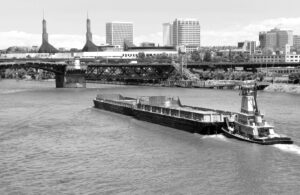The Gulf Intracoastal Waterway (GIWW) stands as a testament to a nation’s commitment to uniting her states and people in regular commerce. Stretching over a thousand miles, the GIWW’s creation was a journey that spanned decades, driven by visionary leaders, military necessity, economic potential, and engineering prowess. This history traces the remarkable evolution of the GIWW, from its conceptual roots to becoming a vital lifeline for coastal trade and travel.
Setting the Stage for Transformation
The early 19th century was a time of nation-building, and the need for efficient internal transportation was paramount. In 1808, Albert Gallatin, the U.S. Secretary of the Treasury, submitted a groundbreaking report titled “Public Roads and Canals” to the U.S. Senate. This report served as a clarion call for a comprehensive network of roads and canals to bind the fledgling nation together. It marked the first step toward the realization of the Gulf Intracoastal Waterway.
From Vision to Action
In 1824, the General Survey Act empowered the President to employ Army Engineers to survey routes for roads and canals of national significance. This was a pivotal moment that laid the foundation for the GIWW. Two years later, Congress authorized the first survey for a canal connecting the Atlantic Ocean and the Gulf of Mexico. The realization of the need for a safer, more efficient water route along the coast was gaining momentum.
The GIWW’s transformational journey saw early steps taken to deepen channels and improve waterways. In 1828, Congress allocated funds to deepen a channel near Mobile Bay, signaling the first improvement on the future route of the GIWW. As the years progressed, appropriations and authorizations paved the way for further surveys and examinations, acknowledging the potential of an interconnected network of protected waterways.
A Nation and a Waterway Take Shape
The addition of Florida and Texas to the Union in 1845 marked significant milestones for the evolving GIWW. With the expansion of the United States’ coastal territories, the need for an efficient waterway linking these regions grew even stronger.
Fast-forwarding to the turn of the 20th century, the emergence of vital industries and the discovery of oil in Texas added impetus to the realization of the Gulf Intracoastal Waterway. Reports of surveys and examinations in the early 1900s highlighted the potential for incorporating adjacent water routes into a protected network. The growing push for safer coastal transportation led to the establishment of the Inland Waterways Commission, which laid the groundwork for comprehensive planning and improvements.
The 1920s witnessed significant strides in the development of the GIWW. Congress’s authorization to construct the “Louisiana and Texas Intracoastal Waterway” marked a milestone, treating the waterway as a cohesive whole rather than a disjointed collection of segments. The 1927 extension to Corpus Christi expanded the waterway’s reach, opening the door to enhanced connectivity along the Gulf Coast.
Realizing the Potential of Our Nation’s Waterways
The mid-20th century marked the fruition of decades of effort and vision. Completing the continuous 9-by-100-foot channel between Apalachicola River and New Orleans improved navigability and accessibility. The completion of various segments created a lifeline for coastal trade, fostering economic growth and strategic transportation.
The latter half of the 20th century saw the GIWW’s expansion and modernization, accompanied by challenges and environmental considerations. The authorization of the high-level lock barge canal across Florida and enlargement of the GIWW addressed evolving transportation needs and environmental concerns.
Today, the Gulf Intracoastal Waterway continues to serve as a vital artery for commerce, connecting coastal communities and supporting economic growth. Its historic timeline reflects not only engineering achievements but also the resilience of a nation striving for efficient transportation and economic prosperity.
References: History of the Gulf Intracoastal Waterway, Texas State Historical Association
Barge Companies Experience a Dream Come True
The Gulf Intracoastal Waterway’s evolution, from its conception to its present-day significance, is a testament to the power of vision, engineering innovation, and the collaborative spirit of a nation. Today, as barge companies navigate its waters, they stand on the shoulders of the generations that worked tirelessly to transform a dream into a vital economic lifeline. The Gulf Intracoastal Waterway continues to embody the spirit of innovation, serving as a testament to the nation’s ability to conquer challenges and chart a course toward prosperity.


